Abstract
Twelve healthy male volunteers received phenytoin 0.5 and 1 g, lamotrigine (a new anticonvulsant) 120 and 240 mg, diazepam 10 mg and placebo orally in a double-blind, cross-over, randomized trial. Maximum drug concentrations at 4 h, measured in plasma were 11.5 +/- 2.2 micrograms ml-1 for phenytoin and 2.7 +/- 0.4 micrograms ml-1 for lamotrigine. These levels were in the therapeutic range for phenytoin and the putative therapeutic range for lamotrigine. Side effects after diazepam (mainly sedation) and phenytoin (mainly unsteadiness) differed markedly from lamotrigine which produced no important side effects. Subjective effects as measured by visual analogue scales were caused by phenytoin and diazepam but not by lamotrigine. Diazepam impaired eye movements, adaptive tracking and body sway. Phenytoin impaired adaptive tracking, increased body sway and impaired smooth pursuit eye movement. Lamotrigine produced only a possible slight increase in body sway. There were significant correlations between performance and saliva levels of phenytoin and diazepam. It was concluded that the tests used were suitable for monitoring CNS effects of anticonvulsants and that lamotrigine possibly could have a more favourable CNS side effect profile than phenytoin.
Full text
PDF
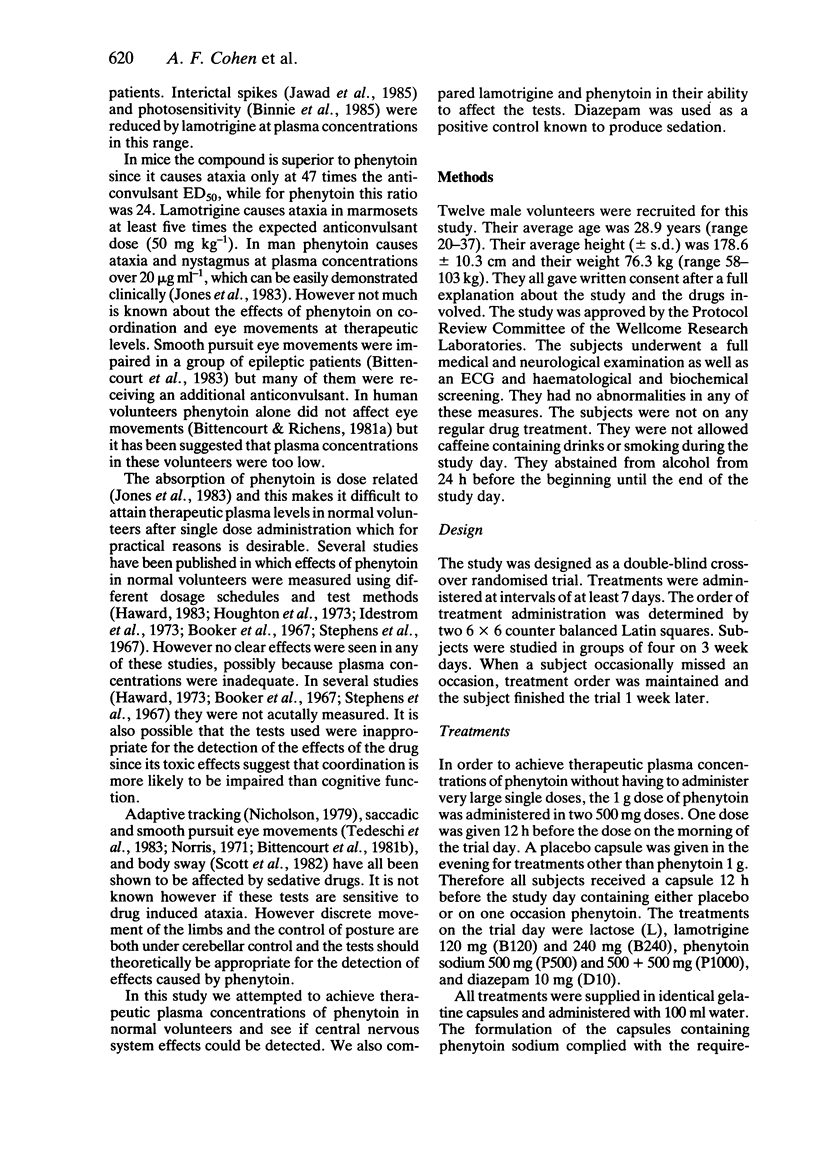

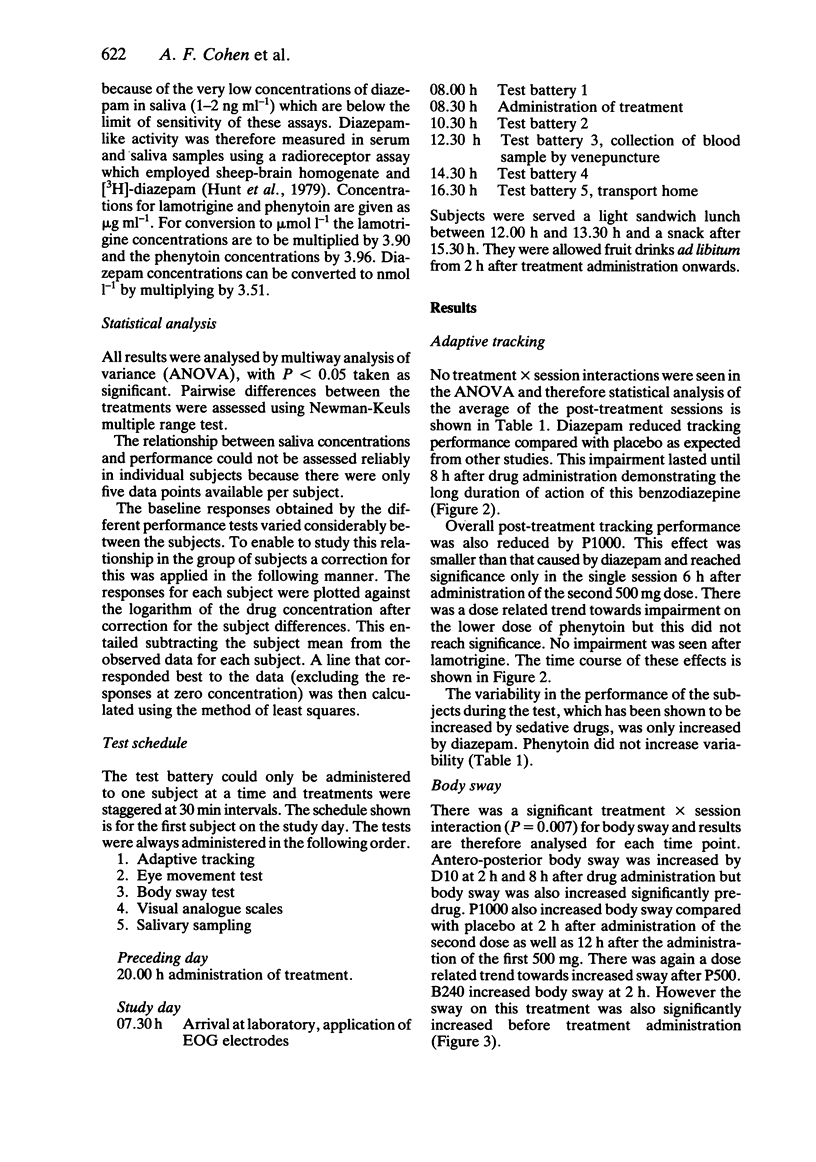
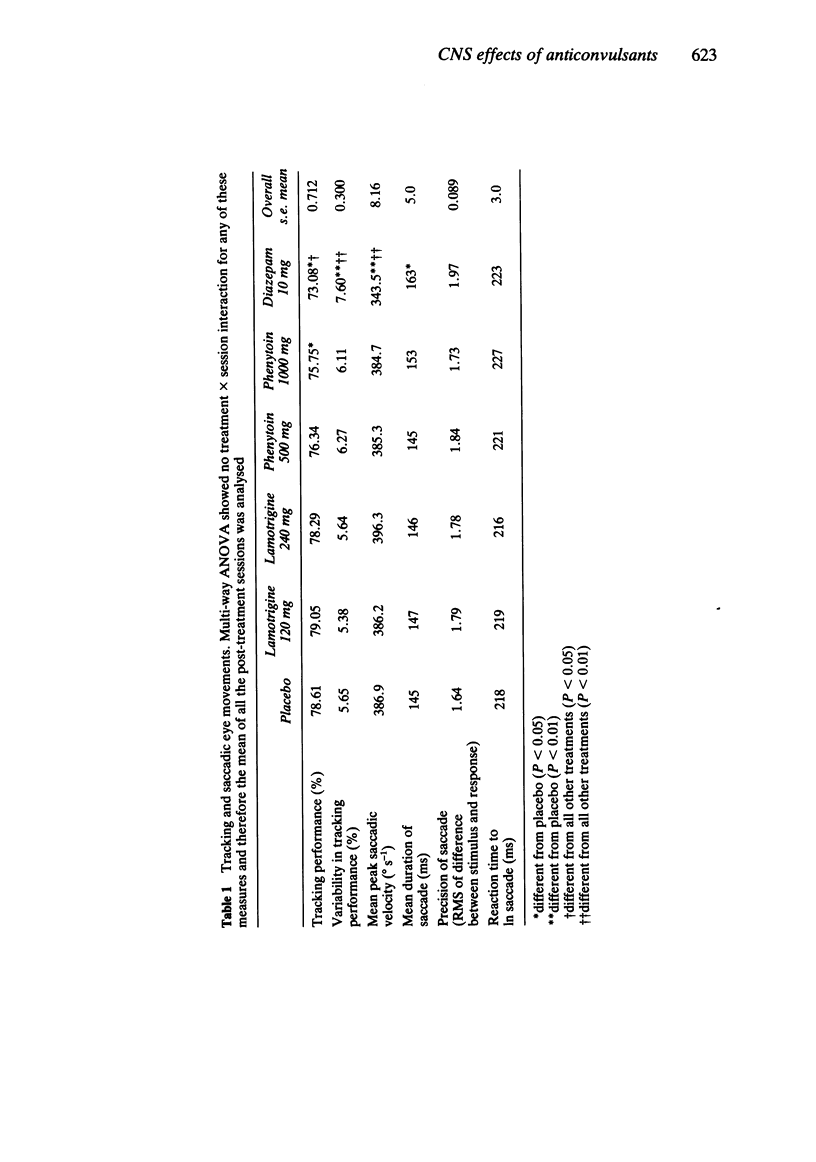

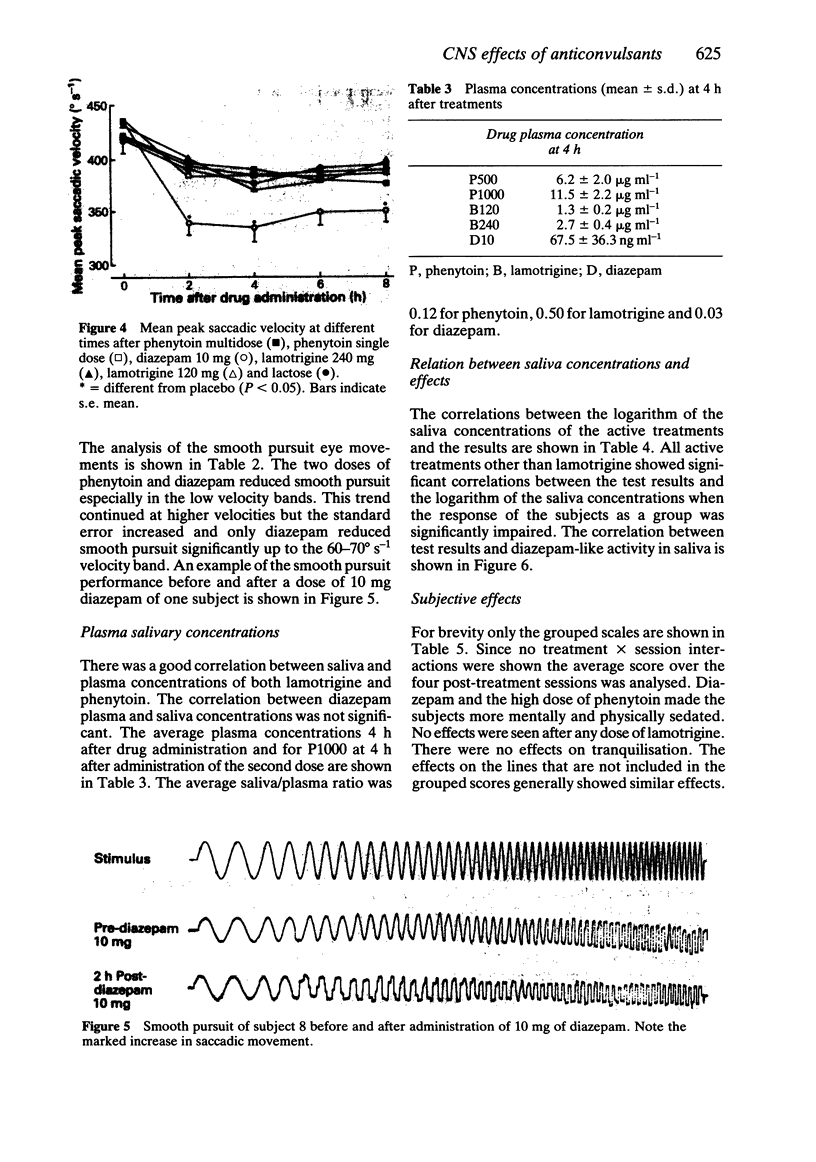


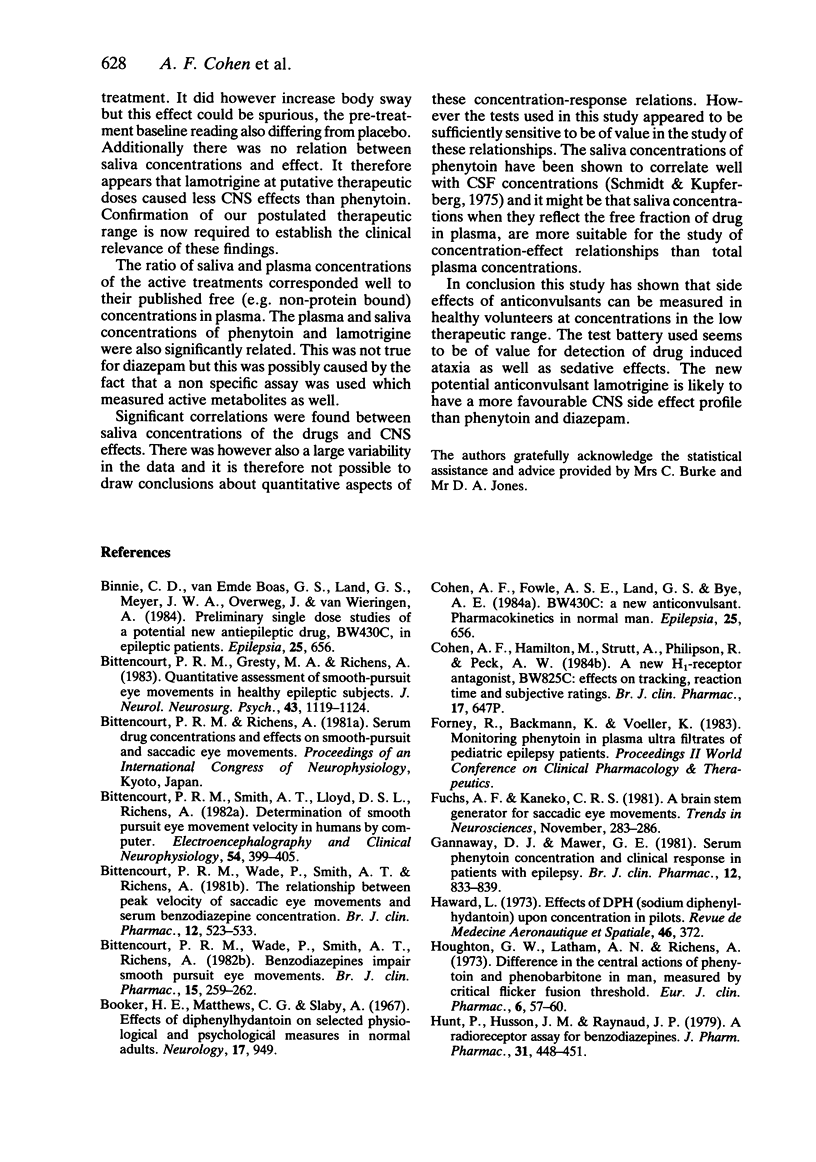

Selected References
These references are in PubMed. This may not be the complete list of references from this article.
- Bittencourt P. R., Gresty M. A., Richens A. Quantitative assessment of smooth-pursuit eye movements in healthy and epileptic subjects. J Neurol Neurosurg Psychiatry. 1980 Dec;43(12):1119–1124. doi: 10.1136/jnnp.43.12.1119. [DOI] [PMC free article] [PubMed] [Google Scholar]
- Bittencourt P. R., Smith A. T., Lloyd D. S., Richens A. Determination of smooth pursuit eye movement velocity in humans by computer. Electroencephalogr Clin Neurophysiol. 1982 Oct;54(4):399–405. doi: 10.1016/0013-4694(82)90203-6. [DOI] [PubMed] [Google Scholar]
- Bittencourt P. R., Wade P., Smith A. T., Richens A. Benzodiazepines impair smooth pursuit eye movements. Br J Clin Pharmacol. 1983 Feb;15(2):259–262. doi: 10.1111/j.1365-2125.1983.tb01495.x. [DOI] [PMC free article] [PubMed] [Google Scholar]
- Bittencourt P. R., Wade P., Smith A. T., Richens A. The relationship between peak velocity of saccadic eye movements and serum benzodiazepine concentration. Br J Clin Pharmacol. 1981 Oct;12(4):523–533. doi: 10.1111/j.1365-2125.1981.tb01261.x. [DOI] [PMC free article] [PubMed] [Google Scholar]
- Booker H. E., Matthews C. G., Slaby A. Effects of diphenylhydantoin on selected physiological and psychological measures in normal adults. Neurology. 1967 Oct;17(10):949–951. doi: 10.1212/wnl.17.10.949. [DOI] [PubMed] [Google Scholar]
- Gannaway D. J., Mawer G. E. Serum phenytoin concentration and clinical response in patients with epilepsy. Br J Clin Pharmacol. 1981 Dec;12(6):833–839. doi: 10.1111/j.1365-2125.1981.tb01316.x. [DOI] [PMC free article] [PubMed] [Google Scholar]
- Houghton G. W., Latham A. N., Richens A. Difference in the central actions of phenytoin and phenobarbitone in man, measured by critical flicker fusion threshold. Eur J Clin Pharmacol. 1973 Jun;6(1):57–60. doi: 10.1007/BF00561802. [DOI] [PubMed] [Google Scholar]
- Hunt P., Husson J. M., Raynaud J. P. A radioreceptor assay for benzodiazepines. J Pharm Pharmacol. 1979 Jul;31(7):448–451. doi: 10.1111/j.2042-7158.1979.tb13551.x. [DOI] [PubMed] [Google Scholar]
- Ideström C. M., Schalling D., Carlquist U., Sjöqvist F. Acute effects of diphenylhydantoin in relation to plasma levels. Behavioral and psychophysiological studies. Psychol Med. 1972 May;2(2):111–120. doi: 10.1017/s0033291700040599. [DOI] [PubMed] [Google Scholar]
- Jones G. L., Wimbish G. H., McIntosh W. E. Phenytoin: basic and clinical pharmacology. Med Res Rev. 1983 Oct-Dec;3(4):383–434. doi: 10.1002/med.2610030403. [DOI] [PubMed] [Google Scholar]
- McGregor A. R., Crookall-Greening J. O., Landon J., Smith D. S. Polarisation fluoroimmunoassay of phenytoin. Clin Chim Acta. 1978 Feb 1;83(1-2):161–166. doi: 10.1016/0009-8981(78)90219-x. [DOI] [PubMed] [Google Scholar]
- Nicholson A. N. Performance studies with diazepam and its hydroxylated metabolites. Br J Clin Pharmacol. 1979;8(1):39S–42S. doi: 10.1111/j.1365-2125.1979.tb00454.x. [DOI] [PMC free article] [PubMed] [Google Scholar]
- Norris H. The action of sedatives on brain stem oculomotor systems in man. Neuropharmacology. 1971 Mar;10(21):181–191. doi: 10.1016/0028-3908(71)90039-6. [DOI] [PubMed] [Google Scholar]
- Riker W. K., Downes H., Olsen G. D., Smith B. Conjugate lateral gaze nystagmus and free phenytoin concentrations in plasma: lack of correlation. Epilepsia. 1978 Feb;19(1):93–98. doi: 10.1111/j.1528-1157.1978.tb05016.x. [DOI] [PubMed] [Google Scholar]
- Robinson D. A. Eye movement control in primates. The oculomotor system contains specialized subsystems for acquiring and tracking visual targets. Science. 1968 Sep 20;161(3847):1219–1224. doi: 10.1126/science.161.3847.1219. [DOI] [PubMed] [Google Scholar]
- Rothenberg S. J., Selkoe D. Specific oculomotor deficit after diazepam. I. Saccadic eye movements. Psychopharmacology (Berl) 1981;74(3):232–236. doi: 10.1007/BF00427100. [DOI] [PubMed] [Google Scholar]
- Schmidt D., Kupferberg J. Diphenylhydantoin, phenobarbital, and primidone in saliva, plasma, and cerebrospinal fluid. Epilepsia. 1975 Dec;16(5):735–741. doi: 10.1111/j.1528-1157.1975.tb04758.x. [DOI] [PubMed] [Google Scholar]
- Scott D. B., Fagan D., Tiplady B. Effects of amitriptyline and zimelidine in combination with ethanol. Psychopharmacology (Berl) 1982;76(3):209–211. doi: 10.1007/BF00432546. [DOI] [PubMed] [Google Scholar]
- Smith A. T., Bittencourt P. R., Lloyd D. S., Richens A. An efficient technique for determining characteristics of saccadic eye movements using a mini computer. J Biomed Eng. 1981 Jan;3(1):39–43. doi: 10.1016/0141-5425(81)90103-5. [DOI] [PubMed] [Google Scholar]
- Tedeschi G., Bittencourt P. R., Smith A. T., Richens A. Specific oculomotor deficits after amylobarbitone. Psychopharmacology (Berl) 1983;79(2-3):187–189. doi: 10.1007/BF00427809. [DOI] [PubMed] [Google Scholar]
- Tedeschi G., Smith A. T., Dhillon S., Richens A. Rate of entrance of benzodiazepines into the brain determined by eye movement recording. Br J Clin Pharmacol. 1983 Jan;15(1):103–107. doi: 10.1111/j.1365-2125.1983.tb01471.x. [DOI] [PMC free article] [PubMed] [Google Scholar]


